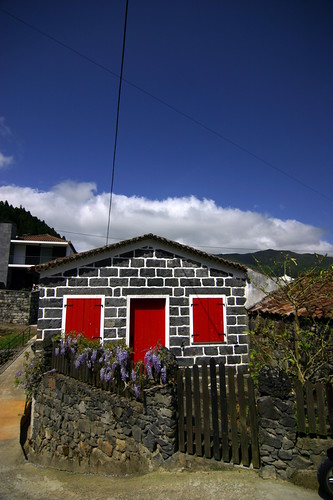The Azores were formed by an active volcanic hotspot at the bottom of the ocean on the crevice of three tectonic plates. The islands are the tops of volcanoes that rise from the depths of the ocean and reach up 1000-2000 m above sea level. The Pico Mountain is the highest mountain of the Mid-Atlantic Ridge. The evidence of volcanic activity from the past can still be seen, smelt, and felt on the different islands. Even quite recently, volcanic eruptions occurred on some of the islands.
The volcanic rock found on the Azores is mainly composed of basaltic lava, which is a common bedrock material of the Mid-Atlantic Ridge. Powerful volcanic explosions in the region created so called Caldeiras, or craters, that are found scattered over the islands. On the continents, volcanic eruptions are usually followed by earthquakes, but on the oceanic islands this seismographic activity is minimal. However, on the Azores volcanic eruptions are accompanied by severe shocks. In 1998 an earthquake
destroyed many houses on the island of Faial.
A volcano that produces lava with a low viscosity can easily push the lava through its main pipe. What is special about the Azores is the fact that the earths crust in the Azorean plateau is relatively thick. Consequently, the lava has to travel a longer distance to the earth’s surface, which causes changes in its composition. This results in a type of lava that is characterised by a high level of acidity, called trachiet. Trachiet is less fluid than other types of basaltic lava and therefore forms clumps. In order to push the lava through the channels in the earth’s crust an enormous pressure has to be build up. Often the lava crystallises within these channels, causing the pressure to rise even more. After a period of simmering or ‘sleeping’ the volcano has built up enough pressure to push the lava out.
During these eruptions not only the lava is blown out, but also a part of the volcano can explode.
This is how the caldeiras and crater lakes on the islands were created. One can imagine that the volcano of Faial was once much higher than the Pico volcano. Its caldeira is located at an altitude of 1100m. The Pico Alte has not yet build up enough pressure to explode, being much younger than the volcanoes on the other islands. The Pico volcano has been inactive for many years. Only at the top, where small clouds of steam escape through tiny crevices, one can feel the warmth of the volcano. This simmering volcano could wake up again.
All of the islands except Corvo and Santa Maria have hot springs and sulphate springs. On Graciosa (Carapacho) and São Miguel (Furnas), health centres (Spas) have been built in order to benefit from these mineral springs.
All the information and local insights you need for the most wonderful holidays in the Azores Islands.
Thursday, March 13, 2008
Vulcanisme - Azores - Açores
Subscribe to:
Post Comments (Atom)
Açores - Azores - São Miguel - Furnas
Açores - Azores - São Miguel - Furnas , originally uploaded by Luis Miguens .

-
Açores - Azores - São Miguel - Furnas , originally uploaded by Luis Miguens .
-
Impressive group of lavas next to the sea, perforated by many grottoes and tunnels. Volcanic arches over the sea. Rocks with curious shapes,...
-
Terceira Island ( Portuguese: Ilha Terceira) is an island in the Azores, in the middle of the North Atlantic Ocean, with an area of 396.75 k...


No comments:
Post a Comment